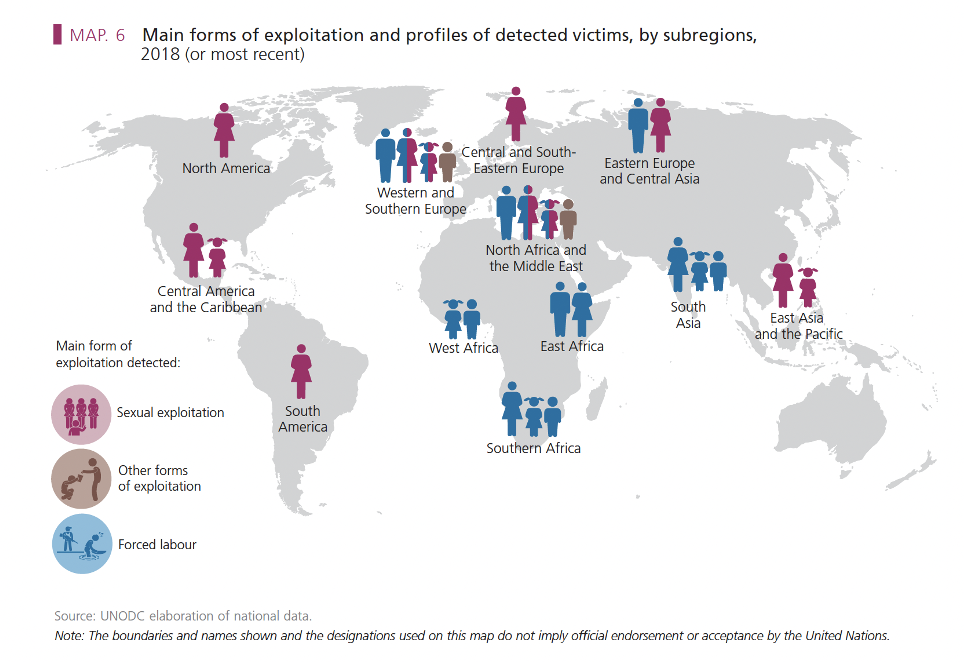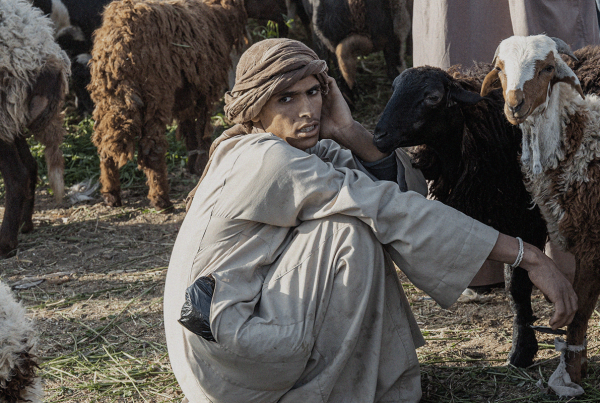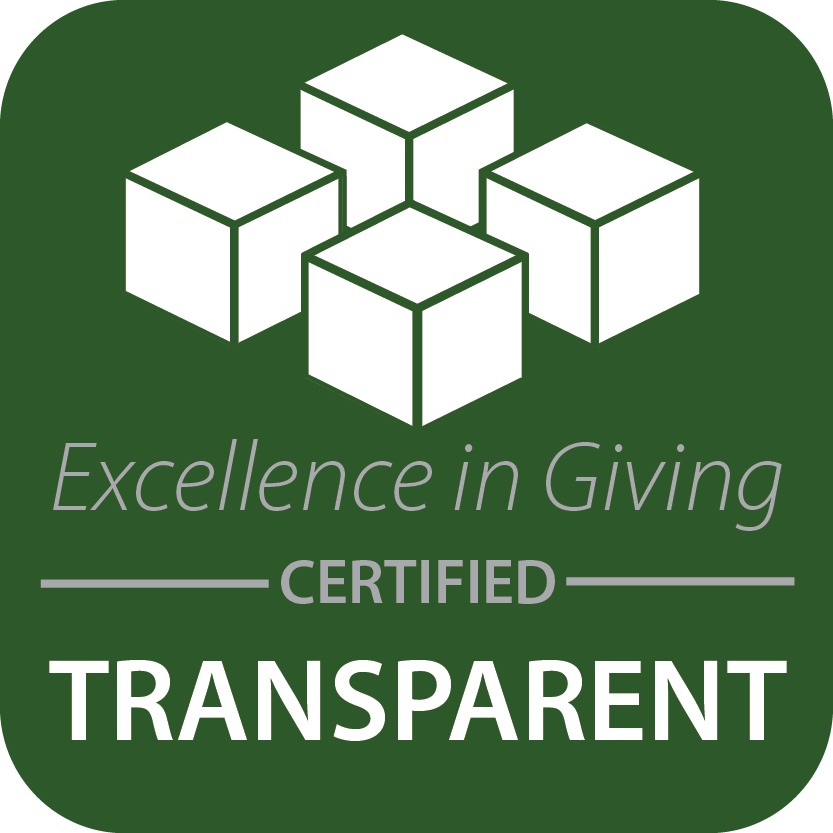Where does human trafficking occur? The short answer is that it happens everywhere. But it’s more common in some places than others. Learn the regions where human trafficking is the most prevalent.
Human trafficking occurs everywhere.
No continent, no country, no state is an exception. Human trafficking, or modern-day slavery, happens on both a domestic and global front. While the immediate impact is local, the long-term consequences are widespread and far-reaching.
Human trafficking victims are bought, sold, and abused within their own countries and across borders. According to the International Labour Organization’s Global Estimates of Modern Slavery released in September 2022, an estimated 49.6 million people were the victims of forced labor and forced marriage at any given time in 2021. 6.3 million of these were victims of forced commercial sexual exploitation.
Where is human trafficking most prevalent?
According to the ILO’s latest data, the Asia and Pacific region has the highest number of victims of forced labor and marriage, accounting for more than half of the global total — 29.6 million. However, if we take population size into account and examine the prevalence per thousand people, then the Arab States have the highest rate of exploitation at 10.2%.
The regions of the world, ranked by number of people in human trafficking:
- Asia and the Pacific: 29.3 million
- Africa: 7 million
- Europe and Central Asia: 6.4 million
- Americas: 5.1 million
- Arab States: 1.7 million
The regions of the world, ranked by prevalence (per thousand people) of human trafficking:
- Arab States: 10.1%
- Europe and Central Asia: 6.9%
- Asia and the Pacific: 6.8%
- Africa: 5.2%
- Americas: 5%
Source: ILO, Global Estimates of Modern Slavery: Forced Labour and Forced Marriage, 2021
What countries rank the worst for human trafficking?
The Global Organized Crime Index assesses the criminality level of 193 countries, along with their resilience to organized crime. According to the 2021 report, human trafficking has become the most pervasive criminal activity in the world. Informed by qualitative and quantitative measures and expert input, the five worst-scoring countries for human trafficking are:
- Libya
- Eritrea
- Yemen
- United Arab Emirates
- Turkmenistan
One major reason Libya ranks worst is because of the destabilization in the country that started with the 2014 civil war. According to the U.S. State Department’s 2022 Trafficking in Persons Report on Libya, large areas of the country have been outside of government control, and the judicial system has not been fully functioning. Extra-legal armed groups and criminal groups are reported to be involved in sex and labor trafficking, exploiting migrants, refugees, and asylum seekers.
Three out of these worst-ranked countries — Libya, Eritrea, and Yemen — are marked by civil conflict, a lack of a rule of law, or political instability. Two of the countries are accused of government-compelled forced labor: in agriculture in Turkmenistan and in military service in Eritrea.
The outlier among these five countries is the United Arab Emirates (UAE). The majority of the workforce in UAE — 90 percent — is recruited globally. Many of these migrant workers are in conditions of forced labor, such as passport retention, failure to pay wages, and restriction of movement.
Does human trafficking mainly occur in low-income countries?
Human trafficking is a concern for both low- and high-income countries. However, looking at the prevalence per thousand population, low- and lower-middle-income countries have the highest rates of exploitation. Child trafficking in particular is more prevalent in low-income countries where children are forced to enter the workforce.
However, if we look at the numbers per million, over half of all forced labor exploitation occurs in either middle- or high-income countries. Likewise, while forced marriages are more prevalent in lower-middle-income countries, it still remains a problem in wealthier countries. High- and upper-middle-income countries account for 26% of forced marriages.
Number of people in human trafficking by country income level:
- Lower-middle-income countries: 23 million
- Upper-middle-income countries: 12.7 million
- High-income countries: 7.2 million
- Low-income countries: 6.6 million
Prevalence of human trafficking (per thousand people) by country income level:
- Low-income countries: 9.6%
- Lower-middle-income countries: 7.8%
- High-income countries: 5.9%
- Upper-middle-income countries: 4.4%
Source: ILO, Global Estimates of Modern Slavery: Forced Labour and Forced Marriage, 2021
Where do the different types of trafficking happen most?
The UNODC’s latest report highlights the main types of exploitation and the dominant profile of the victims in each region. Detected victims are categorized into four profiles: men and women (adults), girls and boys (under 18). The main types of exploitation identified are sexual, forced labor, and other (forced begging, organ trafficking, etc.).
In the Americas, human trafficking victims are predominantly women subjected to sexual exploitation. The same is true of East Asia and the Pacific. However, there is a higher prevalence of child trafficking there than in the Americas. In contrast, in most of Africa, forced labor is the more common form of exploitation. Here are the main forms of exploitation by subregion:

Main forms of exploitation in The Americas
- North America: sexual exploitation of women
- Central America & the Caribbean: sexual exploitation of women and girls
- South America: sexual exploitation of women
Main forms of exploitation in Europe
- Western & Southern Europe: forced labor of men, the forced labor and sexual exploitation of women and girls, other forms of exploitation of boys
- Central & Eastern Europe: sexual exploitation of women
Main forms of exploitation in Africa & the Middle East
- North Africa & the Middle East: forced labor of men, the forced labor and sexual exploitation of women and girls, other for boys
- West Africa: forced labor of boys and girls
- East Africa: forced labor of men and women
- Southern Africa: forced labor of women, girls, and boys
Main forms of exploitation in Asia & the Pacific
- Central Asia: forced labor of men and sexual exploitation of women
- South Asia: forced labor of women, girls, and boys
- East Asia & the Pacific: sexual exploitation of women and girls
The Human Trafficking Global Data Set
In order to paint a clearer picture of human trafficking on a global scale, the Counter Trafficking Data Collaborative (CTDC) has created a centralized global data set using information from organizations around the world. According to their data, exploitation, whether forced labor, sexual, or otherwise, occurs in 189 countries worldwide and amongst 187 different nationalities. You can visit the CTDC Global Data Set Interactive Map to hone in on the human trafficking statistics of specific countries.
It’s important to note that the data we have on human trafficking is based on the number of detected victims and is therefore most likely underreported. Exploitation could also be occurring in other areas where there is less awareness, enforcement efforts, and investigations. Rural areas where little to no enforcement exists may appear to have fewer cases in comparison to large cities where larger-scale investigations are taking place.
Many victims of human trafficking are not even aware that they are victims, and many people do not know what to look for when it comes to identifying victims of exploitation. Educating ourselves and our communities about human trafficking is essential if we are to understand how to identify and help individuals experiencing exploitation.
Visit our TraffickWatch Academy to equip yourself with the knowledge to fight human trafficking on a local and global scale.







